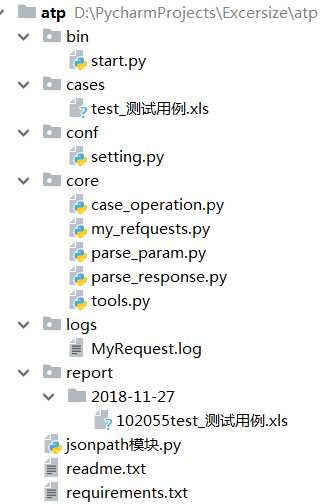标签:order deb sel ftime odi time() mail header ssl
代码结构:
bin---启动文件 cases---存放测试用例 conf ---配置文件 core --- 核心代码 logs --- 日志 report --- 存放测试结果 readme.txt --- 使用说明 requirements.txt-----保存所有安装的第三方模块,方便代码移植到其他电脑
写代码思路:
1、读excel取出所有用例 2、解析用例 1) 解析入参: a =1,b=1,phone=<phone> 把入参变成字典 {‘a‘=1,‘b‘:2,‘phone‘:15326687945} url 请求方式:post 2) 发请求,获取到返回结果 MyRequest 3) 解析返回 a、解析检查点 ‘k=1,age=18,name!=abc‘ [[‘k‘,‘=‘,‘1‘],[‘age‘,‘=‘,‘18‘],[‘name‘,‘!=‘,‘abc‘]] b、获取实际结果做对比,检查用例通过还是失败 3、返回结果写入到excel中 4、生成报告,发邮件
readme.txt
写用例的支持参数化,支持以下参数化: <phone> 自动产生手机号 <id_card> 身份证号 <email> 邮箱 <cur_time> 当前时间戳
requirements.txt
xlrd
requests
jsonpath
xlutils
nnlog
yagmail
case_operation.py

import xlrd from core.my_requests import MyRequest ‘‘‘ 读exce获取用例 ‘‘‘ def get_case(path): all_case = [] #定义一个二维数组,保存所有的测试用例 book = xlrd.open_workbook(path) sheet = book.sheet_by_index(0) for i in range(1,sheet.nrows): #第一行表头不要 row_data = sheet.row_values(i)[4:8] #切片(顾头不顾尾),取4-7列:请求url、请求方式、请求数据、预期结果 all_case.append(row_data) return all_case #[[url,get,data,check],[url,get,data,check]] ‘‘‘ 发request请求 ‘‘‘ def send_request(url,method,data,headers=None): req = MyRequest(url,data,headers=headers) #实例化一个MyRequest实例 if method.upper()=="POST": #测试用例中的请求方式可能是大写或小写 res = req.post() elif method.upper() ==‘GET‘: res = req.get() else: res = {"data":"暂时不支持该方法!"} return res[‘data‘]
my_requests.py 封装请求模块类 处理了异常,打印了日志

import requests import nnlog import os from conf.setting import LOG_PATH class MyRequest: log_file_name = os.path.join(LOG_PATH,‘MyRequest.log‘) #日志存放在cases文件夹下 time_out = 10 #请求超时时间 def __init__(self,url,data=None,headers=None,file=None): self.url = url self.data = data self.headers = headers self.file = file def post(self): try: req = requests.post(self.url,data=self.data,headers=self.headers, files=self.file,timeout=self.time_out) except Exception as e: res = {"status":0,"data":e.args} #0代表请求失败 else: try: res = {"status":1,"data":req.json()} #1代表返回的json except Exception as e: res = {"staus":2,"data":req.text} #2代表返回不是json log_str = ‘url: %s 请求方式:post data:%s ,返回数据:%s‘%(self.url,self.data,res) self.write_log(log_str) return res def get(self): try: req = requests.get(self.url,params=self.data,headers=self.headers,timeout=self.time_out) except Exception as e: res = {"status":0,"data":e.args} #0代表请求失败 else: try: res = {"status":1,"data":req.json()} #1代表返回的json except Exception as e: res = {"staus":2,"data":req.text} #2代表返回不是json log_str = ‘url: %s get请求 data:%s ,返回数据:%s‘%(self.url,self.data,res) self.write_log(log_str) return res @classmethod #类方法 def write_log(cls,content): log = nnlog.Logger(cls.log_file_name) log.debug(content)
parse_param.py

import random import string import time #这个类是用来解析请求参数的 class ParseParam: func_map = [‘phone‘,‘email‘,‘id_card‘,‘cur_time‘] #映射函数的 def __init__(self,param): self.param = param self.parse() #实例化时就做映射 def phone(self): phone_starts = [‘134‘,‘181‘,‘138‘,‘177‘,‘150‘,‘132‘,‘188‘,‘186‘,‘189‘,‘130‘,‘170‘,‘153‘,‘155‘] #手机号开头3位固定 start = random.choice(phone_starts) end = str(random.randint(0,99999999)) #产生手机号后8位 res = start+ end.zfill(8) return res def email(self): email_end=[‘163.com‘,‘qq.com‘,‘126.com‘,‘sina.com‘] end = random.choice(email_end) start_str=‘ATP_test_‘ email_start = ‘‘.join(random.sample(string.ascii_letters+string.digits,6)) #从所有的大写字母、小写字母、数字中取6位 sample取到的是list,用join转成字典 return start_str+email_start+‘@‘+end def id_card(self): ‘‘‘这个产生身份证号的‘‘‘ return 410881199011212121 def cur_time(self): return int(time.time()) #time.time()精确的毫秒 int()取整 def order_id(self): ‘‘‘从数据库里面获取‘‘‘ pass def session_id(self): ‘‘‘从redis里面获取的‘‘‘ pass def parse(self): for func in self.func_map: temp = str(getattr(self,func)()) #手机号 self.param = self.param.replace(‘<%s>‘%func,temp) def strToDict(self): #这个函数是把请求参数转成字典的 data ={} pl = self.param.split(‘,‘) for p in pl: temp = p.split(‘=‘) if len(temp)>1: #用例中不一定key value都写完整了,最好先判断是否都存在,否则会报错 key,value = temp data[key] = value return data if __name__ == ‘__main__‘: param = ‘username=niuhanyang‘ ‘,phone=<phone>,email=<email>‘ ‘,id_card=<id_card>,start_time=‘ ‘<cur_time>‘ p = ParseParam(param) data = p.strToDict() print(data) print(p.phone()) res = getattr(p,‘phone‘) #getattr()是一个内置函数,第一个参数是一个对象,第二个参数是一个字符串(方法的名字) 获取一个对象里面的属性(方法、变量) print(res()) #返回的res是一个函数名,加()就可以调用了 import os,requests res = hasattr(requests,‘get‘)#第一个参数-模块名 第二个参数-字符串(方法的名字) 判断某个模块、类下面有没有某个方法或者变量 print(res) #True
parse_response.py

import jsonpath class ResponseParse: seqs = [‘!=‘, ‘>=‘, ‘<=‘, ‘=‘, ‘<‘, ‘>‘, ‘in‘, ‘notin‘] #定义支持的运算符 def __init__(self,response,check): #response是请求返回实际值 check是用例中的期望值 self.response = response self.check = check def format_check(self): #格式化检查信息,分别列出key 运算符 实际结果 #会返回 [[‘error_code‘,‘=‘,‘0‘],[‘name‘,‘!=‘,‘xxx‘]] format_list = [] check_list = self.check.split(‘,‘) for s in check_list: for seq in self.seqs: if seq in s: if len(s.split(seq))>1: key, value = s.split(seq) temp = [key, seq, value] format_list.append(temp) break return format_list def get_real_value(self,key): #从字典里面获取key对应的value res = jsonpath.jsonpath(self.response,‘$..%s‘%key) #$..%s这个是jsonpath这个模块的用法 if res: return res[0] return ‘找不到该key【%s】‘%key def operation_check(self,real,seq,hope): #根据运算符判断结果 msg = "判断信息:%s %s %s "%(real,seq,hope) real = str(real)#注意:为了保持类型一致 返回值从字典中取出可能是int类型,先转成str hope从字符串中取出来的,一定是字符串 if seq == ‘=‘: status = real == hope elif seq == ‘!=‘: status = real != hope elif seq ==‘in‘: status = real in hope elif seq == ‘notin‘: status = real not in hope else: status,msg = self.num_check(real,seq,hope) return status,msg def num_check(self,real,seq,hope): #判断数值类型的 > < >= <= msg = "判断信息:%s %s %s "%(real,seq,hope) try: real = float(real) hope = float(hope) except Exception as e: msg = "比较时出错,大小比较只能是数字类型!" "%s %s %s"%(real,seq,hope) status = False else: if seq == ‘>‘: status = real > hope elif seq == ‘<‘: status = real < hope elif seq == ‘<=‘: status = real <= hope else: status = real >= hope return status,msg def check_res(self): #校验所有的检查点 check_list = self.format_check() #format_check()返回的是一个二维数组,循环取出每条出来判断 # [[‘error_code‘, ‘=‘, ‘0‘], [‘name‘, ‘!=‘, ‘xxx‘]] all_msg=‘‘ for check in check_list:#循环所有的检查点 key,seq,hope = check real = self.get_real_value(key) #在response里找到key对应的值 status,msg = self.operation_check(real,seq,hope) all_msg = all_msg+msg+‘\n‘ #累加提示信息 if status: pass else: return ‘失败‘,all_msg return ‘通过‘,all_msg #所有的check点都pass才返回pass,有一个失败就返回fail
tool.py

import xlrd from xlutils.copy import copy import os import datetime from conf import setting import yagmail def make_today_dir(): #创建当天的文件夹,返回绝对路径 today = str(datetime.date.today()) #c:/xxx/xxx/atp/report/2018-11-24/测试用例.xls abs_path = os.path.join(setting.REPORT_PATH,today) #拼成当天的绝对路径 if os.path.exists(abs_path): pass else: os.mkdir(abs_path) return abs_path def write_res(case_path,case_res): #c:/xxx/xxx/atp/cases/测试用例.xls #[ [‘{"xdfsdf}‘,‘通过‘],[‘{"xdfsdf}‘,‘失败‘] ] book = xlrd.open_workbook(case_path) new_book = copy(book) sheet = new_book.get_sheet(0) #xlutils 里不能用 sheet_by_index()方法 for row,res in enumerate(case_res,1): #1 表示row要从1开始取 response,status = res # 写第8列和第9列 sheet.write(row,8,response) sheet.write(row,9,status) cur_date_dir = make_today_dir()#创建当前文件夹,并且返回绝对路径 file_name = os.path.split(case_path)[-1] #只获取到filename cur_time = datetime.datetime.today().strftime(‘%H%M%S‘) #获取到当天时分秒 new_file_name = cur_time+‘_‘+file_name #165530_测试用例.xls real_path = os.path.join(cur_date_dir,new_file_name)#拼路径 测试报告放在report目录下 new_book.save(real_path) return real_path def send_mail(content,file_path=None): #发邮件,传入邮件正文和附件 m = yagmail.SMTP(**setting.MAIL_INFO,) subject = ‘接口测试报告_%s‘%str(datetime.datetime.today()) m.send(subject=subject,to=setting.TO,contents=content,attachments=file_path)
setting.py

import os #常量定义时大写 BAE_PATH = os.path.dirname(os.path.dirname(os.path.abspath(__file__))) #atp的目录 LOG_PATH = os.path.join(BAE_PATH,‘logs‘) #log目录 CASE_PATH = os.path.join(BAE_PATH,‘cases‘) #case目录 REPORT_PATH = os.path.join(BAE_PATH,‘report‘) #report目录 #发邮件相关信息 MAIL_INFO = { #定义为字典,调用时用**MAIL_INFO即可 ‘user‘:‘xxxx@qq.com‘, ‘password‘:‘sdfsdf‘, ‘host‘:‘smtp.qq.com‘, #163邮箱 smtp.163.com ‘smtp_ssl‘:True, #发件箱是qq邮箱的话,为True } TO = [‘xxxx@qq.com‘,‘4xxx7026@qq.com‘]
start.py

#首先将该project目录加入到python环境变量 import os,sys BAE_PATH = os.path.dirname(os.path.dirname(os.path.abspath(__file__))) #atp的目录 sys.path.insert(0,BAE_PATH) from conf.setting import CASE_PATH from core import case_operation,parse_param,parse_response from core import tools import glob class RunCase: content = ‘‘‘ 各位好! 本次测试结果:总共运行%s条用例,通过%s条,失败%s条。详细信息见附件。 ‘‘‘ def get_excel(self): #s=‘/Users/nhy/test*.xls‘ for excel in glob.glob(os.path.join(CASE_PATH,‘test*.xls‘)): #glob模块过滤--只要以test开头,.xls结尾的文件 cases = case_operation.get_case(excel)#调用读取excel的函数 results = self.send_requests(cases) #发送请求,并校验结果 返回一个二维数组[[real_res,status],[real_res,status],.....] report_file_path = tools.write_res(excel,results)#写入结果,返回的是测试结果的路径 all_count = len(cases) #总共多条用例 fail_count = all_count - self.success_count #失败用例条数 content = self.content%(all_count,self.success_count,fail_count) tools.send_mail(content,report_file_path) def send_requests(self,cases): #发送多个请求 #[[url,get,data,check],[url,get,data,check]] self.success_count = 0 #类变量,保存成功用例条数 results = [] for case in cases: url,method,param,check = case #获取到每条用例的参数 p = parse_param.ParseParam(param) #解析请求参数 实例化一个ParseParam实例 ,实例化的过程中就将里面的<phone>,<email>等替换了 data = p.strToDict()#请求参数转成字典 response = case_operation.send_request(url,method,data)#发请求 send_request()发送单个请求,返回结果是一个string #下面这2行代码是判断用例执行是否通过的 p2 = parse_response.ResponseParse(response,check) #实例化一个ResponseParse实例 status, msg = p2.check_res()#调用写好的校验结果方法, real_res = str(response)+‘\n‘+msg #是把校验的信息和返回的json拼到一起 results.append([real_res,status]) #这里面的小list是每一个用例运行的结果 if status == ‘通过‘: self.success_count += 1 #统计成功的次数 return results #返回运行的结果 def main(self): print(‘开始测试‘.center(50,‘*‘)) self.get_excel() print(‘测试结束‘.center(50,‘*‘)) if __name__ == ‘__main__‘: run = RunCase() run.main()
标签:order deb sel ftime odi time() mail header ssl
原文地址:https://www.cnblogs.com/HathawayLee/p/10027810.html